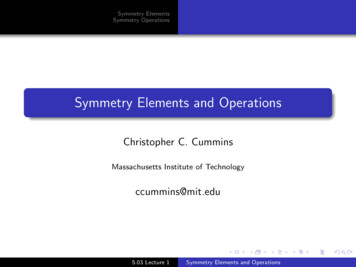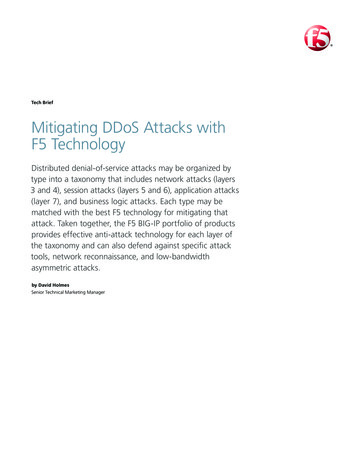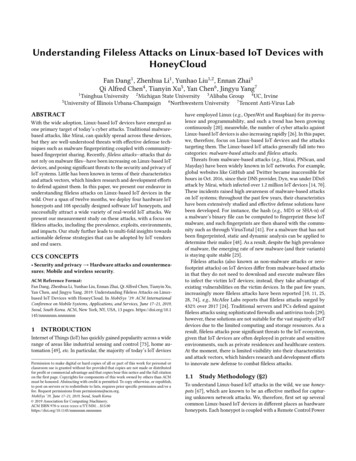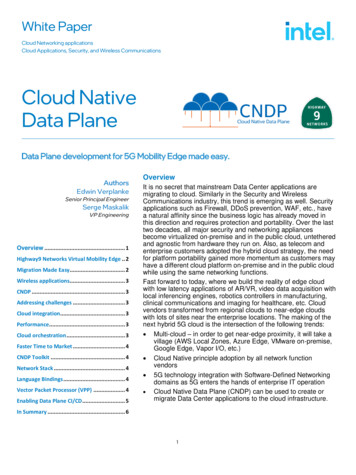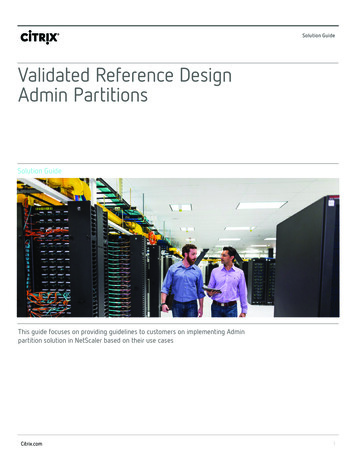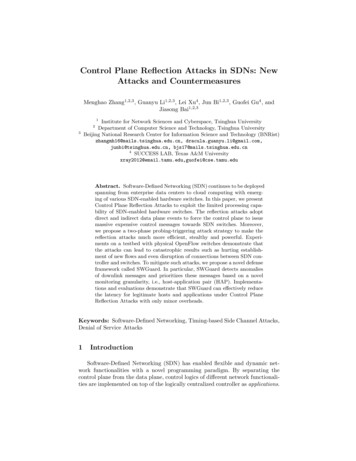
Transcription
Control Plane Reflection Attacks in SDNs: NewAttacks and CountermeasuresMenghao Zhang1,2,3 , Guanyu Li1,2,3 , Lei Xu4 , Jun Bi1,2,3 , Guofei Gu4 , andJiasong Bai1,2,31Institute for Network Sciences and Cyberspace, Tsinghua UniversityDepartment of Computer Science and Technology, Tsinghua UniversityBeijing National Research Center for Information Science and Technology (BNRist)zhangmh16@mails.tsinghua.edu.cn, dracula.guanyu.li@gmail.com,junbi@tsinghua.edu.cn, bjs17@mails.tsinghua.edu.cn4SUCCESS LAB, Texas A&M edu23Abstract. Software-Defined Networking (SDN) continues to be deployedspanning from enterprise data centers to cloud computing with emerging of various SDN-enabled hardware switches. In this paper, we presentControl Plane Reflection Attacks to exploit the limited processing capability of SDN-enabled hardware switches. The reflection attacks adoptdirect and indirect data plane events to force the control plane to issuemassive expensive control messages towards SDN switches. Moreover,we propose a two-phase probing-triggering attack strategy to make thereflection attacks much more efficient, stealthy and powerful. Experiments on a testbed with physical OpenFlow switches demonstrate thatthe attacks can lead to catastrophic results such as hurting establishment of new flows and even disruption of connections between SDN controller and switches. To mitigate such attacks, we propose a novel defenseframework called SWGuard. In particular, SWGuard detects anomaliesof downlink messages and prioritizes these messages based on a novelmonitoring granularity, i.e., host-application pair (HAP). Implementations and evaluations demonstrate that SWGuard can effectively reducethe latency for legitimate hosts and applications under Control PlaneReflection Attacks with only minor overheads.Keywords: Software-Defined Networking, Timing-based Side Channel Attacks,Denial of Service Attacks1IntroductionSoftware-Defined Networking (SDN) has enabled flexible and dynamic network functionalities with a novel programming paradigm. By separating thecontrol plane from the data plane, control logics of different network functionalities are implemented on top of the logically centralized controller as applications.
2Menghao Zhang and et al.Typical SDN applications are implemented as event-driven programs which receive information directly or indirectly from switches and distribute the processing decisions of packets to switches accordingly. These applications enable SDNto adapt to data plane dynamics quickly and make responses to the application policies timely. A wide range of network functionalities are implemented inthis way, allowing SDN-enabled switches to behave as firewall, load balancing,network address translation, L2/L3 routing and so on.Despite the substantial benefits, the deployment of SDN has encountered several problems. In particular, a major limitation is the control message processing capability on SDN-enabled hardware switches of various brands (e.g., IBMRackSwitch, Juniper Junos MX-Series, Brocade NetIron CES 2000 Series, Pica8Series, Hewlett-Packard Series), constrained by multiple factors. First, CPUsof hardware switches are usually relatively wimpy [1, 2] for financial reasons,which restricts the message parsing and processing capability of software protocol agents in switches. Second and more importantly, flow tables in most commodity hardware OpenFlow switches use Ternary Content Addressable Memory(TCAM) to achieve wire-speed packet processing, which only allows limited flowtable update rate (only supporting 100-200 flow rule updates per second [2–8])and small flow table space (ranging from hundreds to a few thousand [1,3,9]) dueto manufacturing cost and power consumption. These limitations have sloweddown network updates and hurt network visibility, which further constrain thecontrol plane applications with dynamic policies significantly [10].In this paper, we systematically study the event processing logic of theSDN control plane and locate two types of data plane events which could reflect expensive control messages towards the data plane, i.e., direct data planeevents (e.g., Packet-In messages) and indirect data plane events (e.g., StatisticsQuery/Reply messages). By manipulating those data plane events, we presenttwo novel Control Plane Reflection Attacks in SDN, i.e., Table-miss Striking Attack and Counter Manipulation Attack, which can exploit the limited processingcapability for control messages of SDN-enabled hardware switches. Moreover, inorder to improve accuracy and efficiency of Control Plane Reflection Attacks,we propose a two-phase attack strategy, i.e., probing phase and triggering phase,inspired by timing-based side channel attacks. Control Plane Reflection Attacksare able to adjust attack stream patterns adaptively and cleverly, thus could gaina great increment of downlink messages5 . Extensive experiments with a physicaltestbed demonstrate that the attack vectors are highly effective and the attackeffects are pretty obvious.In order to mitigate Control Plane Reflection Attacks, we present a noveland effective defense framework, namely SWGuard. SWGuard proposes a newmonitoring granularity, host-application pair (HAP) to detect downlink messageanomalies, and prioritizes downlink messages when downlink channel congests.In this way, SWGuard is able to satisfy the latency requirements of differenthosts and applications under the reflection attacks.5For brevity, we denote the messages from the data plane to the control plane asuplink messages, and the messages vice versa as downlink messages.
Control Plane Reflection Attacks3To summarize, our main contributions in this paper include:– We systematically study the event processing logic of SDN applications andfurther locate two types of data plane events, i.e., direct/indirect events,which could be manipulated to reflect expensive control messages towardsSDN switches.– We present two novel Control Plane Reflection Attacks, Table-miss Striking Attack and Counter Manipulation Attack, to exploit limited processingcapability of hardware switches. Moreover, we develop a two-phase attackstrategy to launch such attacks in an efficient, stealthy and powerful way.The experiments with a physical SDN testbed exhibit their harmful effects.– We present a defense solution, called SWGuard, with an efficient priorityassignment and scheduling algorithm based on the novel abstraction of hostapplication pair (HAP). Implementations and evaluations demonstrate thatSWGuard provides effective protection for legitimate hosts and applicationswith only minor overheads.The remainder of this paper is structured as follows. Section 2 introducesthe background that motivates this work. Section 3 illustrates the details ofControl Plane Reflection Attacks and Section 4 proves the harmful effects witha physical testbed. We present our SWGuard defense framework in Section 5and make some discussions in Section 6. Related works are illustrated in Section7, and the paper is concluded in Section 8.2BackgroundProcessing Logic of Data Plane Events. SDN introduces the open network programming interface and accelerates the growth of network applications,which enable network to dynamically adjust network configurations based oncertain data plane events. These events could be categorized into the followingtwo types: direct data plane events such as Packet-In messages, where the eventvariations are reported to the controller from the data plane directly, and indirect data plane events such as Statistics Query/Reply messages, where the eventvariations are obtained through a query and reply procedure at the controller. Inthe first case, the controller installs a default table-miss flow rule on the switch.When a packet arrives at the switch and does not match any other flow rule, theswitch will forward the packet to the control plane for further processing. Thenthe controller makes decisions for the packet based on the logics of the applications, and assigns new flow rules to the switch to handle subsequent packetswith the same match fields. In the second case, the controller first installs acounting flow rule reactively or proactively on the switch for a measurementpurpose. When a packet matches the counting flow rule in the flow table, thespecific counter increments with packet number and packet bytes. To obtain thestatus of the data plane, the controller polls the flow counter values for statistics periodically and performs different operations according to the analysis ofstatistics. A large number of control plane applications combine these two kinds
4Menghao Zhang and et al.of data plane events to compose complicated network functions, which furtherachieve advanced packet processing.Usage Study of Data Plane Events. Based on the event-driven programming paradigm, a large number of control plane applications emerge in bothacademia and industry. In academia, since the publication of OpenFlow [11],many research ideas have been proposed to fully leverage the benefits of directand indirect data plane events. While the direct data plane events are needed byalmost all applications, the indirect data plane events are also widely included.In particular, we have categorized these indirect event-driven applications intothree types, applications which help improve optimization, monitoring and security of network. Please see our technical report [12] for details. Although eachof them has different purposes, all of these works are deeply involved in theutilization of the indirect data plane events, obtaining a large number of trafficfeatures and switch attributes. Meanwhile, these indirect data plane events contribute a large part of communication between applications and switches. SDNapplications have also experienced great development in industry recently. Themainstream SDN platforms (e.g. Open Daylight, ONOS, Floodlight) foster openand prosperous markets for control plane softwares, which provide a great rangeof applications with a composition of the direct and indirect data plane events.Meanwhile, since these applications are obtained from a great variety of sources,their quality could not be guaranteed and their logics may contain various flawsor vulnerabilities. In particular, we have investigated all mainstream SDN controllers, and discovered that indirect event-driven applications occupy a largepart of application markets in these open source controller platforms. Due tothe page limit, please see the application summary in our technique report [12].Limitations of SDN-enabled Hardware Switches. Compared with therapid growth of packet processing capability in logically centralized and physically distributed network operating systems (e.g., Onix [13], Hyperflow [14], Kandoo [15]) and controller frameworks (e.g., Open Daylight, ONOS), the downlinkmessage processing capability of SDN-enabled hardware switches evolves muchslower. State-of-the-art SDN-enabled hardware switches [16] only support 8192flow entries. To make matters worse, the capability to update the entries inTCAM is pretty limited, usually less than 200 updates per second [2–8, 10]. According to our experiment on Pica8 P-3922, the maximum update rate is about150 entries per second. We observe that the downlink channel in switches isthe dominant resource in SDN architecture that must be carefully managed tofully leverage the benefits of SDN applications. However, existing SDN architecture does not provide such a mechanism to protect the downlink channel in theswitches that it is vulnerable to Control Plane Reflection Attacks.3Control Plane Reflection AttacksIn this section, we first provide our threat model and then describe the detailsof two Control Plane Reflection Attacks including Table-miss Striking Attackand Counter Manipulation Attack.
Control Plane Reflection Attacks3.15Threat ModelWe assume an adversary could possess one or more hosts or virtual machines(e.g., via malware infection) in the SDN-based network. The adversary can utilizehis/her controlled hosts or virtual machines to initiate probe packets, monitortheir responses, and generate attack traffic. However, we do not assume theadversary can compromise the controller, applications or switches. In addition,we assume the connections between the controller and switches are well protectedby TLS/SSL.3.2Control Plane Reflection AttacksControl Plane Reflection Attacks are much more stealthy and sophisticatedthan previous straightforward DoS attacks against SDN infrastructure, and generally consist of two phases, i.e., probing phase and triggering phase. Duringthe probing phase, the attacker uses timing probing packets, test packets anddata plane stream to learn the configurations of control plane applications andtheir involvements in direct/indirect data plane events. With several trials, theattacker is able to determine the conditions that the control plane applicationadopts to issue new flow rule update messages. Upon the information obtainedfrom probing phase, the attacker can carefully craft the patterns of attack packetstream (e.g., header space, packet interval) to deliberately trigger the controlplane to issue numerous flow rule update messages in a short interval to paralyze the hardware switches. We detail two vectors of Control Plane ReflectionAttacks as follows.Table-miss Striking Attack. Table-miss Striking Attack is an enhanced attack vector from previous Data-to-control Plane Saturation Attack [17–20]. Instead of leveraging a random packet generation method to carry out the attack,Table-miss Striking Attack adopts a more accurate and cost-efficient manner byutilizing probing and triggering phases.The probing phase is to learn confidential information of the SDN controlplane to guide the patterns of attack packet stream. The attacker could firstprobe the usage of the direct data plane events (e.g., Packet-In, Packet-Out,Flow-Mod ) by using various low-rate probing packets whose packet headers arefilled with deliberately faked values. The attacker can send these probing packetsto the SDN-based network and observe the responses accordingly, thus the roundtrip time (RTT) for each probing packet could be obtained. If several packetswith the same packet header get different RTT values, especially, the first packetgoes through a long delay while the other packets get relatively quick responses,we can conclude that the first packet is directed to the controller and the otherpackets are forwarded directly in the data plane, which indicates that the specificpacket header matches no flow rules in the switch and invokes Packet-In andFlow-Mod messages. Then the attacker could change one of the header fields withthe variable-controlling approach. With no more than 42 trials6 , the attacker is6The latest OpenFlow specification only support 42 header fields, which constrainsthe field the controller could use to compose different forwarding policies.
6Menghao Zhang and et al.able to determine which header fields are sensitive to the controller, i.e., thegrain for routing. Then the attacker could carefully craft attack packet streambased on probed grains to deliberately trigger the expensive downlink messages.Counter Manipulation Attack. Compared with Table-miss Striking Attack,Counter Manipulation Attack is much more sophisticated, which is based onthe indirect data plane events (e.g., Statistics Query/Reply messages). In orderto accurately infer the usage of the indirect data plane events, three types ofpacket streams are required, i.e., timing probing packets, test packets and dataplane stream. The timing probing packets are inspired by the time pings in [5],which must involve the switch software agent and get the responses accordingly.However, we believe that they have a wider range of choices. The test packets area sequence of packets which should put extra loads to the software agent of theswitch, and must be issued at an appropriate rate for the accuracy of probing.The data plane stream is a series of stream templates, and should directly gothrough the data plane (i.e., do not trigger table-miss entry in the flow table ofthe switch), which is intended to obtain more advanced information such as thespecific conditions which trigger indirect event-driven applications.Timing probing packets are used to measure the workload of software agentof a switch, which should satisfy three properties: first, they should go to thecontrol plane by hitting the table-miss flow rule in the switch, and trigger theoperations of the corresponding applications (e.g., Flow-Mod or Packet-Out).Second, each of them must evoke a response from the SDN-based network, sothe attacker could compute the RTT for each timing probing. Third, they shouldbe sent in an extremely low rate (10 pps is enough), and put as low loads aspossible to the switch software agent. We consider there are many options fortiming probing packets, e.g., ARP request/reply, ICMP request/reply, TCP SYNor UDP. For layer 2, we consider ARP request is an ideal choice since the SDNcontrol plane must be involved in the processing of ARP request/reply. We notethat sometimes the broadcast ARP request will be processed in the switches.However, the corresponding ARP reply is a unicast packet so that the controlplane involvement is inevitable if the destination MAC (i.e., the source MACaddress of the ARP Request) has not been dealt by the controller before. Asa result, the attacker could use spoofed source MAC address to deliberatelypollute the device management service of the controller as well as incur theinvolvement of the controller. In some layer 2 network, it is not possible tosend packets with random source MAC addresses due to pre-authorized networkaccess control policies. To address this, the attacker could resort to the flowrule time-out mechanism of OpenFlow. The attacker would select N benignhosts and send ARP request to them to get the responses. N should satisfythat N R T , where R denotes the probing rate and T denotes the flowrule time-out value7 . For Layer 3, ICMP is a straightforward choice, since itsRTT calculation has been abstracted as ping command already. The attackershould choose a number of benign hosts to send ICMP packets and get the7As R is less than 10 usually, and T is set as a small value in most controllers (e.g. 5in Floodlight), thus N cannot be a large number.
Control Plane Reflection Attacks7corresponding responses. As for layer 4, TCP and UDP are both feasible whena layer 4 forwarding policy is configured in the control plane. According to RFC792 [21], when a source host transmits a probing packet to a port which is likelyclosed at the destination host, the destination is supposed to reply an ICMP portunreachable message to the source. Similarly, RFC 793 [22] requires that eachTCP SYN packet should be responded with a TCP SYN/ACK packet (openedport) or TCP RST packet (closed port) accordingly. With the probing packetreturned with the corresponding response, the RTT could be calculated and thetime-based patterns could be obtained.Test packets are used to strengthen the effects of timing probing packetsby adding extra loads to the software agent of the switch. For the purpose,we consider test packets with a random destination IP address and broadcastdestination MAC address are ideal choices. By hitting the table-miss entry, eachof them would be directed to the controller. Then the SDN controller will issuePacket-Out message to directly forward the test packet. As a result, the aim ofburdening switch software agent is achieved.Data plane stream is a series oftemplates, which should go directlythrough the data plane to obtain Template Coordinate AxisVariablesmore advanced information such as Name(v, p)the specific conditions for indirect Data plane Rateevent-driven applications. We provide stream with (pps)steady ratevtwo templates here, as shown in Fig.1. The first template has a steadyrate v, packet size p, which is mainly0 t 2t 3t 4t 5t T(s)used to probe volume-based statistic Data plane(v, t, p)Ratecalculation and control method. The stream with (pps)second has a rate distribution like a 0-1 ratevjump function, where three variables(v, t, p) determine the shape of this0 t 2t 3t 4t 5t T(s)template as well as the size of eachpacket, which is often used to probe Fig. 1: Templates for data plane streamthe rate-based strategy.The insight of probing phase ofCounter Manipulation Attack lies in that different kinds of downlink messageshave diverse expenses for the downlink channel. Among the interaction approaches between the applications and the data plane, there are mainly threetypes of downlink messages, i.e., Flow-Mod, Statistics Query and Packet-Out.Flow-Mod is the most expensive one among them, since it not only consumesthe CPU of switch agent to parse the message, but also involves the ASIC APIto insert the new flow rules8 . Statistics Query comes at the second, for it needsthe involvement of both switch agent CPU for packet parsing and ASIC API forstatistic querying. These two types of messages are extremely expensive when the8Moving old flow entry to make room for the new flow rule is an important reason tomake this operation expensive and time-consuming.
8Menghao Zhang and et al.occupation of flow table is high on the switch. Packet-Out is rather lightweight,since it only involves the CPU of switch protocol agent to perform the corresponding action encapsulated in the packet. As these three types of downlinkmessages incur different loads for the switch, the latencies of timing probingpackets will vary when the switch encounters different message types. Thus, theattacker could learn whether the control plane issue a Flow-Mod, or a StatisticsQuery, or a Packet-Out. As for the indirect data plane events, the statistic queriesare usually conducted periodically by the applications. As a result, each of thesequeries would incur a small rise for the RTTs of timing probing packets, whichwould reveal the period of application’s statistic query. If a subsequent Flow-Modis issued by the controller, there would be a higher rise of RTT just followingthe RTT for Statistics Query, which is named as double-peak phenomenon. Basedon the special phenomenon, the attacker could even infer what statistic calculation methods the application takes, such as volume-based or rate-based. Withseveral trails of two data plane stream templates above (t is set as the periodof statistic messages, which has been obtained above) and the variations of vand p in a binary search approach, the attacker could quickly obtain the concrete conditions (volume/rate values, number-based or byte-based) that triggerthe expensive downlink messages. The confidential information such as statisticquery period, the exact conditions (volume/rate values, packet number-basedor byte-based) that trigger the downlink messages, helps the attacker permutethe packet interval and packet size of each flow, to deliberately manipulate thecounter value to the critical value, thus each flow would trigger a Flow-Mod inevery period. By initiating a large number of flows, Flow-Mod of equal numberwould be triggered every period, making the hardware switch suffer extremely.4Attack EvaluationIn this section, we demonstrate our experimental results of Control PlaneReflection Attacks with a physical testbed. The evaluations are divided into twoparts. First, we conduct our experiments for Table-miss Striking Attack andCounter Manipulation Attack separately, to show the effectiveness of ControlPlane Reflection Attacks. Second, we perform some benchmarks to provide lowlevel details of our proposed attacks.4.1Experiment SetupTo demonstrate the feasibility of Control Plane Reflection Attacks, we set upan experimental scenario as shown in Fig. 2. We choose several representativeapplications, and run them separately on the SDN controller. Flow tables inthe switch are divided into two pipelines, Counting Table for the indirect dataplane event, Forwarding Table for the direct data plane events. Each pipelinecontains multiple flow entries for the two data plane events, and flow tablesof each pipeline are independent and separated, which is the state-of-the-artapproach for multiple application implementations today [5, 23].
Control Plane Reflection .0.0.2s120.0.0.1OpenFlow Controller lerPica8 3290 SwitchOpenFlow SwitchControlPlane9Software Protocol AgentForwarding CountingTableEngineForwardingTableh210.0.0.2Fig. 2: A Typical Attack Scenarioh110.0.0.1Fig. 3: Attack Experiment SetupsReactive Routing is the most common application integrated into most ofthe popular controller platforms. It monitors Packet-In messages with a defaulttable-miss in Forwarding Table, and computes and installs a path for the hostsof the given source and destination addresses with an appropriate grain. Whenone table-miss occurs, 2N downlink Flow-Mod messages would be issued to thedata plane, where N is the length of the routing path.Flow Monitoring is another common application in SDN-based networks.It is generally implemented with a Counting Table which counts the numberand the bytes of a flow or multiple flows. The controller polls the statistics ofthe Counting Table periodically, conducts analysis on the collected data, andmakes decisions with the analysis results. Further, we extend our Flow Monitoring sketch into four indirect data plane events driven applications, Heavyhitter [24], Microburst [25], PIAS [26] and DDoS Detection [27]. The implementation details are illustrated in our technical report [12].Our evaluations are conducted on a physical OpenFlow Switch, i.e., Pica8P-3290, since it is widely used in academia/industry and supports many advanced OpenFlow data plane features, such as multiple pipelines and almost fullOpenFlow specifications (from version 1.0 to 1.4). The experimental topology,as shown in Fig. 3, includes four machines (i.e., h1, h2, s1, and s2) connectedto the hardware switch and a server running Floodlight Controller. The HTTPservice is run on s1 and s2 separately. We consider h2 is a benign client of theHTTP service and h1 is controlled by the attacker to launch the reflection attack. All the tested applications discussed above are hosted in the Floodlightcontroller. In our experiments, Reactive Routing adopts a five-tuples grainedforwarding policy, and four Flow Monitoring-based applications query the dataplane switch every 2 seconds, and conduct the corresponding control (e.g., issueone Flow-Mod message) according to their logic separately.4.2Attack Feasibility and EffectsIn this subsection, we conduct the experiments for Table-miss Striking Attackand Counter Manipulation Attack separately, and show a detailed procedure forprobing phase and triggering phase.
10Menghao Zhang and et al.5Flowmod Rate(pps)Probing RTTs(ms)43210010 20 30 40 50 60 70 80 90 100Packet Number(a) RTTs for Reactive 0 100 150 200 250 300 350 400 450 500Attack Packet Stream Rate(pps)(b) Attack efficiency for Reactive RoutingFig. 4: Attack feasibility and efficiency for Table-miss Striking AttackTable-miss Striking Attack. For the Reactive Routing application, when welaunch a new flow, the first packet is inclined to get a high RTT, and the followingseveral packets would get low RTTs. Since there are only three hosts on ourtestbed and ping could launch only one new flow between each host pair, weresort to UDP probing packets to cope with this problem. We compute the timedifference between the request and reply to obtain the RTT. As depicted in Fig.4(a), we let h1 transmit 10 UDP probing packets to a destination port and thenchange the destination port. The RTT for the first packet of each flow is quitedistinct from that of the other packets. When we change any field pertainedto five-tuples, the similar results would be obtained. The modification to otherpacket fields would always lead to a quick response. All the phenomena indicatethat five-tuples grained forwarding policy is adopted by the Reactive Routing.With the inference of forwarding grain, the attacker is able to carefully crafta stream of packets whose header spaces vary according to the grain. In thisway, each attack packet could strike the default table-miss in the switch, thustriggering Packet-In and Flow-Mod in the control channel. Data-to-control PlaneSaturation Attack resorts to a random packet generation approach, making theattack not so cost-efficient for the attacker. As we can see in Fig. 4(b), Table-missStriking Attack is much more efficient than Data-to-control Plane SaturationAttack. Further, we also compare the RTTs and bandwidth for normal usersunder the saturation attack and the striking attack. As shown in Fig. 5, thestriking attack could easily obtain a higher RTT and a lower bandwidth usagefor normal users with the same attack expense, which demonstrates that ourTable-miss Striking Attack is much more cost-efficient and powerful.Counter Manipulation Attack. For the Flow Monitoring-based applications,we first supply a steady rate of test packets at 300 packets per second (pps)9 ,which would put appropriate loads on the control plane as required in [5]. Therate of timing probing packets is set as 10 pps. The results for four applications9300 pps is a pretty secure rate, since a legitimate host could issue packets at thousandof pps under normal circumstance.
10 5100010 480010 310 210 110 Striking-point20 40 60 80 100 120 140 160Attack Packet Stream Rate(pps)Bandwidth(Mbits/s)RTTs(ms)Control Plane Reflection n-pointStriking-point600400200002040 60 80 100 120 140 1
In this paper, we systematically study the event processing logic of the SDN control plane and locate two types of data plane events which could re-ect expensive control messages towards the data plane, i.e., direct data plane events (e.g., Packet-In messages) and indirect data plane events (e.g., Statistics Query/Reply messages).
